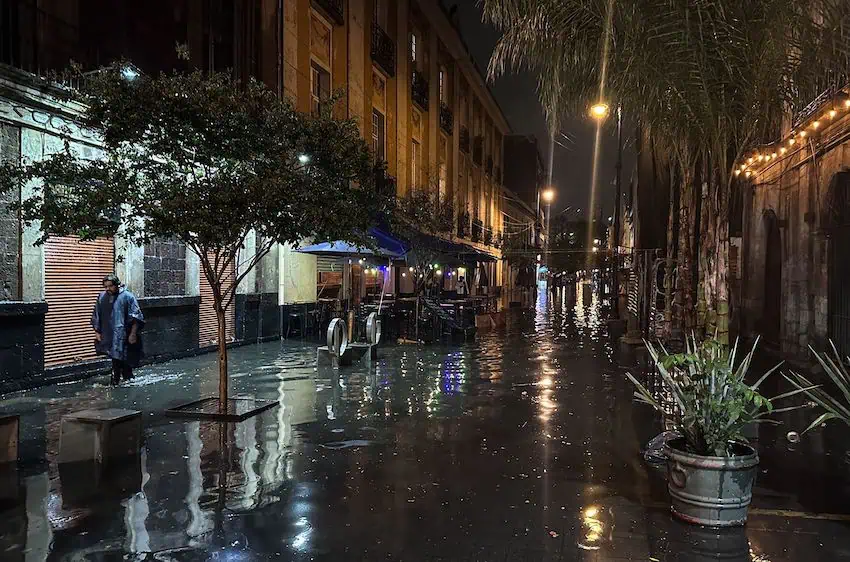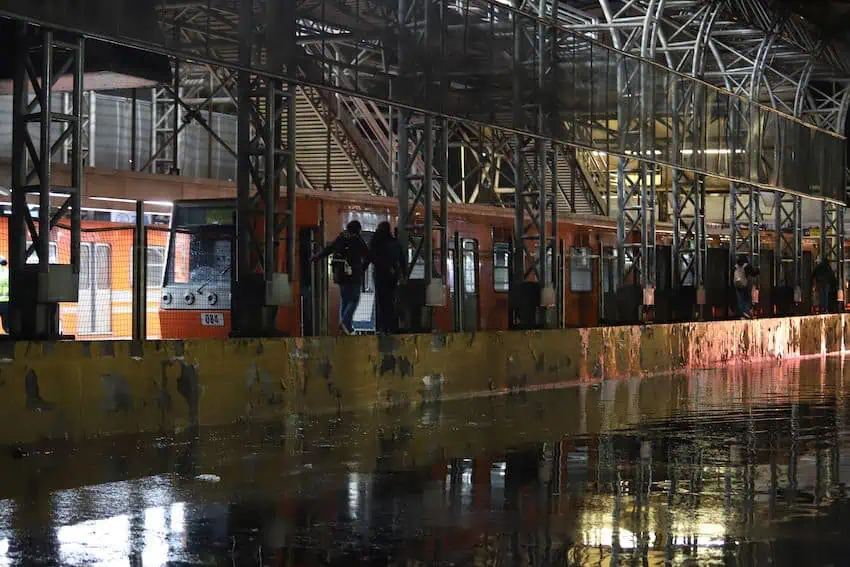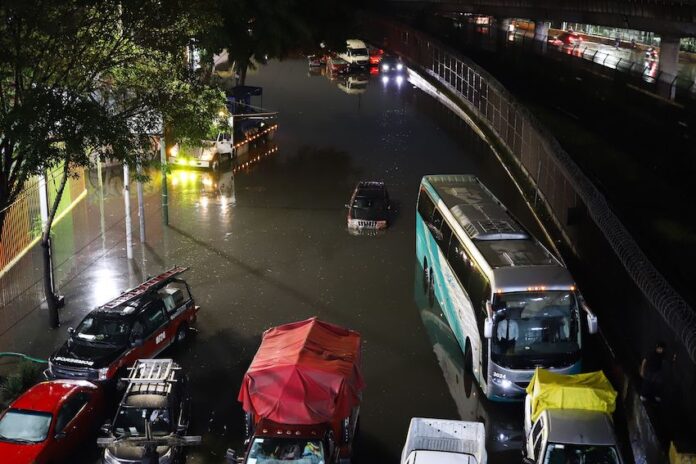Torrential rain in Mexico City on Sunday flooded streets and homes, interrupted services on the subway system and forced the suspension of takeoffs and landings at the capital’s airport for around four hours, affecting more than 100 flights and almost 15,000 passengers.
The rainfall during a storm on Sunday evening was “the most intense” of the 2025 rainy season in the capital, according to Mexico City Water Management Minister José Mario Esparza.
Hail also fell in some parts of the city, where flooding is common during the annual rainy season.
Esparza said on Sunday night that more than 84 millimeters of rain was recorded in the Zócalo, flooding the capital’s central square and other parts of the historic center.
He said that the historic average for rainfall in Mexico City across the month of August is 152 millimeters, meaning that the capital — in its downtown area at least — received more than half the usual amount of rain for this month in a single day.
Mayor Clara Brugada said on social media on Sunday night that the city’s Plan Tlaloque was activated when the heavy rain began in the capital. The activation of the plan put “all emergency services” in Mexico City into action, she said.

The city’s purple alert — the highest warning level for rainfall — was activated in the central Cuauhtémoc borough, while the second-highest level, a red alert, was issued for several other boroughs.
Brugada called on Mexico City residents to exercise caution and only leave their homes if necessary on Sunday night.
There were no immediate reports of injuries or loss of life due to flooding. Cleanup efforts were continuing on Monday.
President Claudia Sheinbaum said Monday that the federal government would provide support to the areas of the capital most affected by the flooding.
More rain is forecast to fall in Mexico City on Monday.
104 flights affected by airport closure
The Benito Juárez International Airport said in a statement on Monday that air operations were suspended for around four hours from 7:45 p.m. to allow water to be cleared from the runways. Poor visibility was also a factor in the decision to suspend takeoffs and landings.
Largas filas de pasajeros se registran en el Aeropuerto internacional de la Ciudad de México, luego de las demoras y cancelaciones de vuelos por las lluvias registradas durante la tarde de ayer. #DíaEnImágenes / Alfredo Domínguez pic.twitter.com/IMfFZvIcWF
— La Jornada (@lajornadaonline) August 11, 2025
The airport said that “the intensity of the atypical storm caused several areas of the terminal buildings to also be affected.”
It said that the rain overwhelmed the airport’s stormwater drainage system.
Video footage showed the baggage claim in Terminal 2 under water on Sunday night.
The airport said that vacuum trucks and motorized pumps were used to remove water and thus “guarantee optimal conditions on runways, taxiways and aprons,” allowing them to reopen early Monday.
It said that 104 flights and 14,892 passengers were affected by the suspension of operations, with incoming flights diverted to “alternate airports.”
The airport said that flights resumed on one runway at 12:05 a.m. Monday, while operations recommenced on the other at 6 a.m. — more than 10 hours after it was closed.
#CDMX ✈️🔴|| Esta noche, la intensa lluvia con tormenta eléctrica obligó al Aeropuerto Internacional de la Ciudad de México (#AICM) a suspender operaciones, dejando pistas inundadas, retrasos de 3 a 4 horas y cancelaciones, incluyendo vuelos de Viva a Los Ángeles, mientras… pic.twitter.com/0OGGoY2dOI
— Primera Línea Mx (@esprimeralinea) August 11, 2025
The Guadalajara and Cancún airports were among the airports to which Mexico City-bound flights were diverted. Some Mexico City-bound flights landed back at the airports from which they took off, including an Air Canada flight that returned to Toronto and an American Airlines flight that returned to Dallas-Fort Worth.
Flooding in various CDMX boroughs
Serious flooding was reported in various parts of Mexico City, including the boroughs of Cuauhtémoc (which includes the historic center), Venustiano Carranza (where the airport is located), Iztacalco and Gustavo A. Madero.
The Lineal Park in Venustiano Carranza, situated in an old drainage canal, filled up with water and overflowed, flooding nearby streets and scores of homes in the area.
“I started crying because it was a desperate situation,” one affected homeowner, María del Consuelo, told TV Azteca.
Parts of the historic center of Mexico City were covered by up to 40 centimeters of water, the El Financiero newspaper reported.
The Zócalo was covered with water and nearby jewelry stores were flooded, something that hadn’t happened in decades, according to El Financiero.
The Metropolitan Cathedral, located opposite the Zócalo, was also affected, with water accumulating in various parts of the edifice. People visiting the cathedral and its personnel banded together to remove the water and avoid major damage to the building’s interior, El Financiero reported.
Flooding was also reported at several Mexico City hospitals, including the Balbuena General Hospital and the Gregorio Salas Hospital in the historic center.
At the Balbuena hospital, firefighters helped move patients out of danger, the newspaper Reforma reported.
CDMX roads and subway system affected
Dozens of roads in Mexico City, including a number of major arteries, were flooded as a result of the intense rainfall on Sunday. Authorities rescued stranded motorists and in some cases removed vehicles from floodwaters.
In the Mexico City Metro system, the downpour on Sunday evening caused the closure of six stations on Line 5 and two stations on Line 3. There was significant flooding outside some of the shuttered stations, all of which had reopened by Monday morning.
On Line 2 of the metro, an explosion and fire occurred near the San Antonio Abad station due to a short circuit caused by the rain. Line 2 services were consequently suspended for around two hours from 7:30 p.m.

Authorities respond to the extreme weather
Esparza, the capital’s water management minister, said that more than 200 personnel from the Water Management Ministry were deployed to respond to the flooding in various parts of Mexico City. They used electric water pumps and other equipment to alleviate flooding.
National Water Commission (Conagua) personnel also assisted the efforts to reduce the flooding.
“Due to the intense rain in the Valley of Mexico, we put 37 pumps into operation to remove 74,000 liters per second,” Conagua said on social media.
“In addition, specialized equipment was sent to [the México state municipalities of] Nezahualcóytl and Ecatepec, with the aim of supporting the population and mitigating the effects of the rain,” the water commission said.
In addition to rescuing stranded motorists, police officers helped to ease flooding by doing what they could to unclog blocked drains.
Rain overwhelms CDMX drainage system
Esparza told the Aristegui news outlet that parts of Mexico City’s deep drainage system collapsed due to the torrential rain.
“The drainage system remains full,” he said on Monday morning.
“In other words, the pipes are at their maximum capacity and everything is now flowing out of the Valley of Mexico to the Tula River basin,” Esparza said.
He said that the accumulation of trash is the main thing that affects Mexico City’s “deep” and “conventional” drainage systems.
Esparza called on residents to be “very careful” with the disposal of their trash to ensure that it doesn’t end up in stormwater drains.
The drainage systems, he said, are designed for average amounts of rainfall. The rain on Sunday, however, was “extraordinary in its volume and intensity,” Esparza said.
With reports from Reforma, TV Azteca, N+, El Universal, Aristegui Noticias, El Financiero, Excélsior and La Jornada
